As reading teachers, our ultimate goal is for our students to be successful and become lifelong readers who enjoy and learn from reading. However, teaching language comprehension in upper elementary can be challenging due to two main factors.
Challenge 1: Many students come to us with gaps in their word recognition or language comprehension skills. Without these essential tools, accessing and understanding text becomes a significant challenge, making it difficult for them to become skilled readers.
Challenge 2: Texts become increasingly complex in upper elementary. Even if our students have a strong foundation in word recognition and language comprehension, they may still struggle to comprehend complex texts if we don’t continue to develop their skills.
Regardless of where our students are on their reading journey, they need ongoing instruction and support in language comprehension. But what exactly is language comprehension, and how can we teach it effectively?
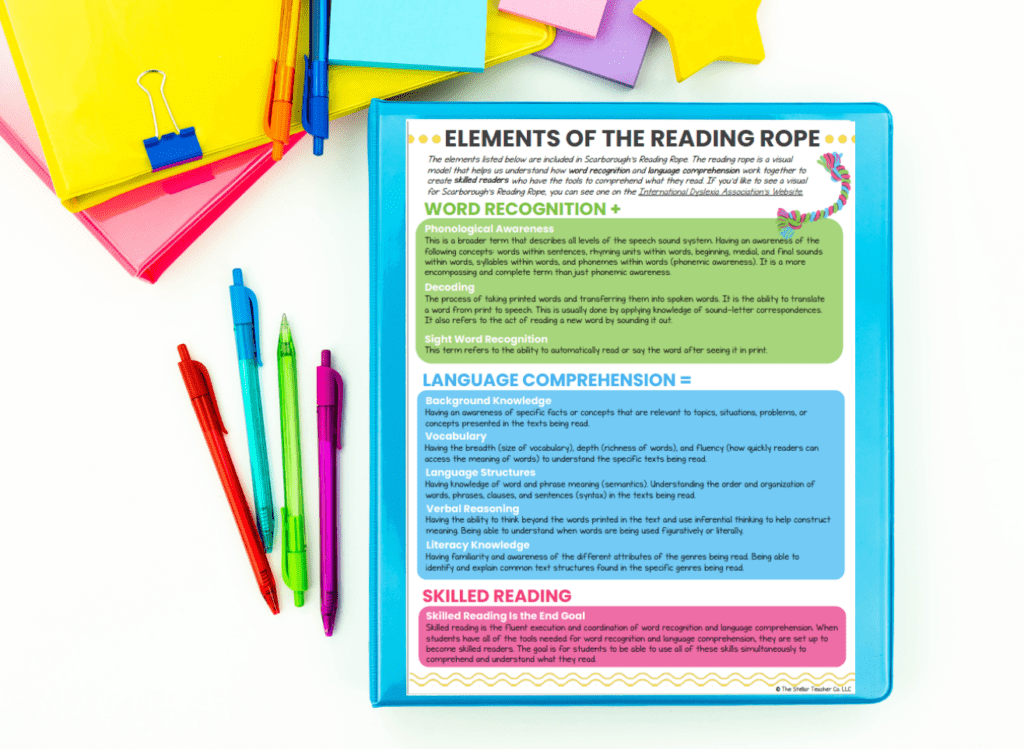
What is language comprehension?
Language comprehension involves several elements that are essential for students to understand and engage with texts fully. These elements include:
- Background knowledge: a foundation of facts, concepts, and ideas that help students make connections between what they already know and new information presented in texts.
- Vocabulary: an extensive knowledge of words and their meanings that allow students to understand and communicate ideas effectively.
- Language structures: understanding how sentences are constructed and recognizing multiple meanings of words.
- Verbal reasoning: the ability to reason through spoken language, make inferences, and draw conclusions.
- Literacy knowledge: an understanding of different genres, writing styles, and literary devices used in texts.
Incorporating these elements into our instruction and providing support to our students in developing their language comprehension skills will go a long way in helping them become skilled and lifelong readers. By taking these steps, we can ensure that our students are equipped with the necessary tools to access and comprehend complex texts, paving the way for their academic and personal success.
Background Knowledge
One key factor in comprehension is background knowledge. But wait, what’s the difference between background knowledge and prior knowledge? And how can you help your students build their background knowledge to become better readers?
- Prior knowledge refers to what students already know about a topic before reading a text.
- Background knowledge is specific information and vocabulary that is essential to understanding a particular text. It’s what the students need to know before they can dive into the text and make sense of it.
Think of it this way: prior knowledge is what students bring to the reading experience, while background knowledge is what they need to gain from the text.
So, how can you help build your students’ background knowledge? Nancy Hennessy in The Reading Comprehension Blueprint provides a great framework for how you can think about background knowledge.
ABCs of Background Knowledge:
- Activate & Assess Background Knowledge
- Build Background Knowledge
- Connect to Existing Background Knowledge
Activate & Assess:
- A KWL Chart is a graphic organizer used in reading instruction to help students activate their prior knowledge, set a purpose for reading, and monitor their comprehension.
- Provide a statement from the text/on the topic and ask students if they agree or disagree and explain why.
Build Background Knowledge:
- This can happen before, during, after reading.
- It can be explicitly teaching vocabulary terms.
- Providing pictures, images, artifacts, text features that support information in the text.
- It can also look like stopping at a teachable moment to make sure students understand the concepts and ideas in the text.
Connect to Existing Knowledge:
- Using sentence stems to help students think more deeply about what they know and what they are reading.
- I used to think. . . I think. . .
- Reading multiple texts on the same topic. Each time we read a text, we have an opportunity to add to our knowledge and connect what we are learning to what we already know, which just enhances our understanding of a topic.
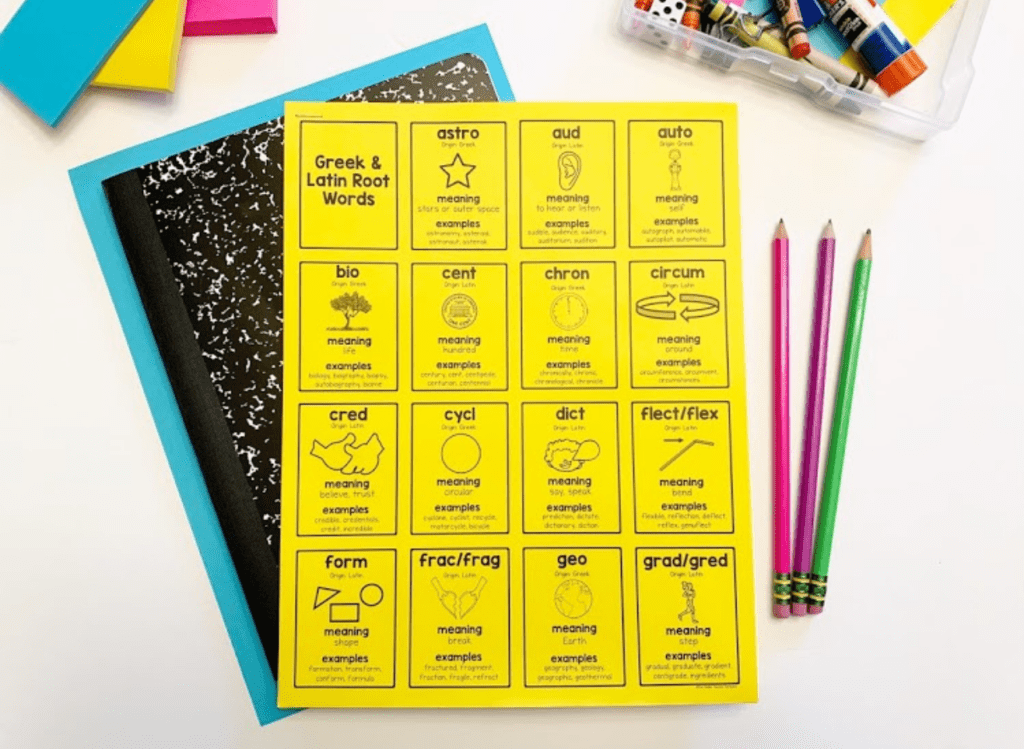
Vocabulary
Vocabulary is an essential aspect of language comprehension that enables us to communicate effectively with one another and understand the content of what we read or hear.
As reading teachers, we want our students to develop a strong vocabulary that encompasses breadth, depth, and fluency.
- Breadth refers to the size of a student’s vocabulary and how many words they know.
- Depth, on the other hand, is about the extent of a student’s word knowledge, including their familiarity with synonyms and content-specific words.
- Fluency pertains to how quickly a student can access the meaning of a word. It is not enough for students to simply know how to spell or read a word; they must also be able to quickly understand its meaning to effectively communicate and comprehend language.
When you think of vocabulary instruction, consider these four things:
Exposing students to new words through
- Read alouds
- Independent reading
- Shared reading
- Incorporating texts in other content areas
Students need to see and hear a wide range of words and exposure to lots and lots of different texts is the best way to get them there.
Explicitly teaching individual words by
- Teaching background knowledge for a specific text
- Introducing vocabulary terminology for another subject are
- Collaborating with your math/science/social studies/art/music teacher coworkers to find out what content specific terms you can teach during your reading/writing block
Use teaching strategies to help students uncover the meaning of new words like
Teaching Morphology (root words, prefix etc.)
- Introduce root words with Root Word of the Week routine – a simple, low prep resource that has everything you need to teach your students various root words a week at a time.
- Introduce common prefixes/suffixes with Prefix & Suffix of the Week routine – a low prep vocabulary routine takes just a few minutes each day and will help your students feel confident in their ability to understand the meaning of common prefixes and suffixes.
These are tools that will help students uncover the meaning of new words.
Teaching the 5 types of context clues. Check out Episode #41 of the podcast for more on this!
- Definition: When a definition is provided within the text, either in the same sentence or in a nearby sentence, to help the reader understand the meaning of the unknown word.
- Synonym: When a synonym for the unknown word is provided within the text, either in the same sentence or in a nearby sentence.
- Antonym: When an antonym for the unknown word is provided within the text, either in the same sentence or in a nearby sentence.
- Example: When an example is given in the text that helps to explain the meaning of the unknown word.
- Inference: When the meaning of the unknown word can be inferred by understanding the context of the sentence or paragraph. This type of context clue requires the reader to use their own background knowledge and critical thinking skills to determine the meaning of the word.
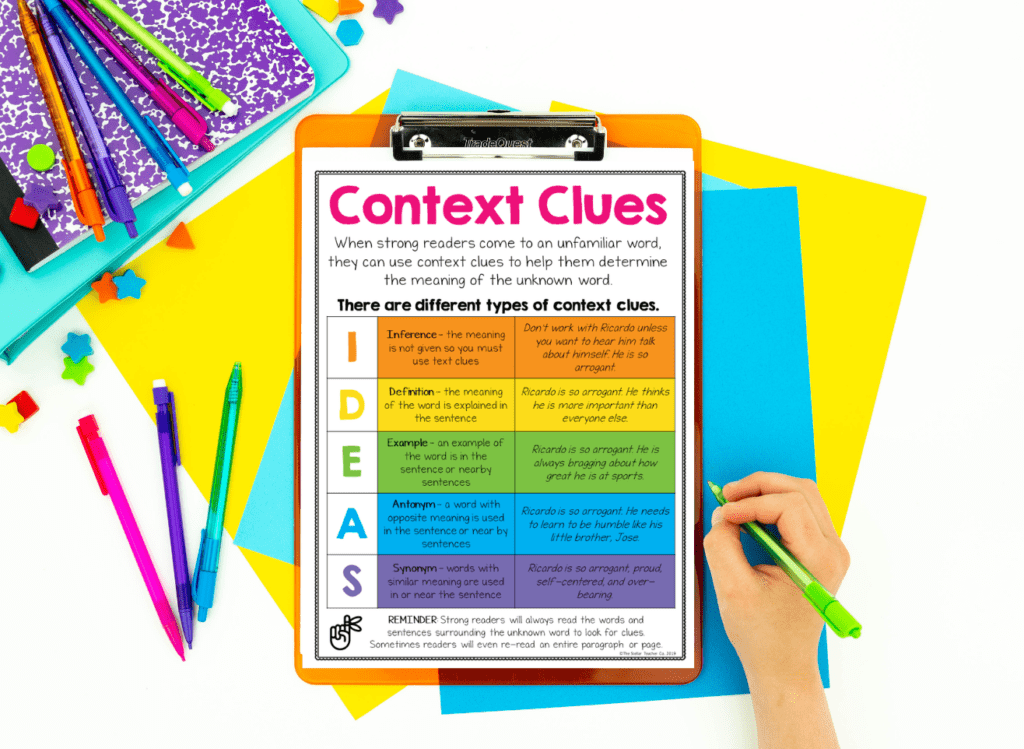
Language Structures
We may think about syntax (sentence structure) from a writing perspective, but forget to consider how sentence structure impacts reading and language comprehension.
The higher the grade, the more complex texts become for our students. A complex text usually has a variety of sentence types and structures like compound and complex sentences. If students don’t understand the structure of a complex sentence, they will have a hard time extracting meaning from it.
Ultimately, when students read a sentence, we want them to understand who or what the sentence is about, and what is happening (noun phrase and verb phrase).
A simple activity that will help students with language structures might look like
- Constructing and deconstructing sentences that are connected to a read aloud.
- Give students a complex sentence from a read aloud and ask them to break it down into the smallest sentence while still maintaining meaning.
- Ask students to build a sentence starting with read aloud concepts.
Option #1: For example, one of the sentences from Each Kindness by Jacqueline Woodson is:
Each morning, I walked to school slowly, hoping this would be the day Maya returned and she’d look at me and smile.
- In that sentence, ultimately you want students to understand that Chloe hoped Maya would return to school. You can eliminate words and phrases until you’re left with that core idea in a sentence.
Option #2: Give students sentence starters to help them build sentences about a read aloud. Such as words to help them build questions:
- Who
- Is doing what
- When
- Where
- How
- Why
They might construct a sentence like Who hoped Maya would return to school?
Verbal Reasoning
If you look at an image of Scarborough’s Reading Rope under verbal reasoning you will see two descriptors: inference and metaphor.
Making inferences and understanding figurative language are definitely apart of verbal reasoning, but this sub-category of language comprehension is more than that!
What is verbal reasoning? Simply put, verbal reasoning is the ability to understand what you read or hear.
This isn’t necessarily something you can teach your students in a single lesson, but it is something we want to consider regularly and reflect on. Two reflection questions you can ask yourself to make sure that you are supporting students with their verbal reasoning:
What support do my students need in order to make connections within the text?
- Text Level: This includes things like, can a student follow a character throughout the story and sequence a text?
- Sentence Level: Can students identify who or what is being referred to by pronouns in the text? For example, if a sentence says, they traveled to a new country… Do students understand who THEY refers to?
What support do my students need in order to connect background knowledge to what is happening in the text?
- For example, if students are reading a text that says, my classroom was a zoo… Do students understand the student doesn’t actually attend classes at a zoo? Are students able to determine the reference as a metaphor giving insight to the reader about the personality and attributes of their classroom.
- Another example of this would be asking students higher-level questions like Why would ______ be a good theme for this book? Would you describe ______ as brave?
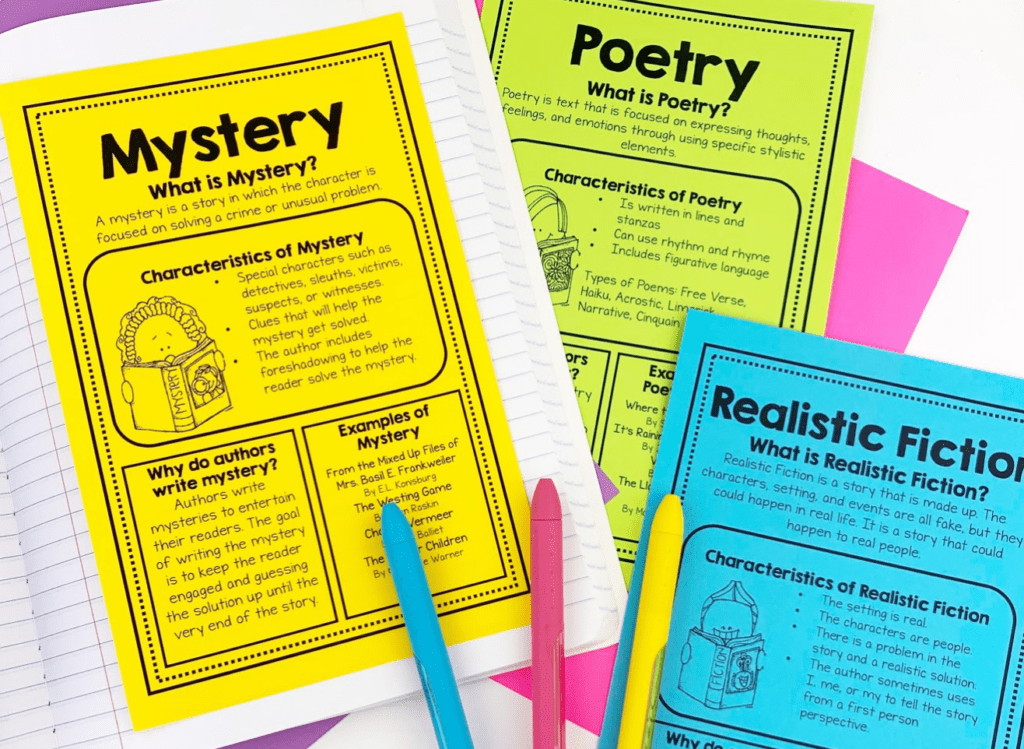
Literacy Knowledge
Literacy knowledge is another element of language comprehension. Literacy knowledge includes genre and text structure. This is probably one of the aspects highlighted in the Science of Reading research that you feel most familiar with!
If you aren’t particularly familiar with these topics I would encourage you to check out two of my previous podcast episodes:
- Episode #49: Nonfiction Text Structure – The Ultimate Roadmap for Reading
- Episode #31 – Why We Should Intentionally Teach Reading Genres
To help your students build up their literacy knowledge it’s important to teach them the attributes of a genre and encourage them to identify those attributes while reading. It’s also important to make sure students understand the difference between narrative (fiction) and nonfiction text structures.
- Narrative Text Structures (Story Mountain) exposition, conflict, rising action, climax, falling action, and resolution
- Nonfiction Text Structure descriptive, sequence, compare & contrast, cause & effect, and problem & solution
What can this look like in your classroom?
- Use questions frames to help students understand different genres and structures.
- Teach students how to draw and apply different graphic organizers connected to structure.
We want our students to be able to practice these language comprehension skills automatically, but to help them reach that point we need to spend time teaching them in isolation and sprinkling them into daily activities like read alouds, small group lessons, independent reading, etc.
They don’t all have to be done every day with every lesson, but we do want to be intentional about thinking about how we are supporting our students’ language comprehension throughout the year and throughout our reading block.
Put It Into Practice:
- Download my freebie The Science of Reading: Teacher Reference Guide to help you build a solid understanding of concepts and vocabulary associated with the science of reading.
- Check out podcast Episode #85 of the podcast: What is The Science of Reading & Why is it Important?
- Join us inside The Stellar Teacher Reading Membership, where you will get access to a resource library filled with reading resources, including resources to help you incorporate all five pillars of reading in your classroom.
Happy Teaching!

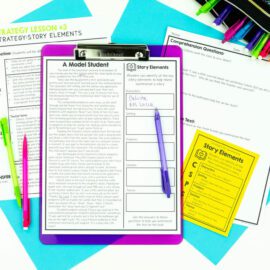
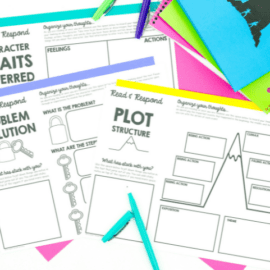
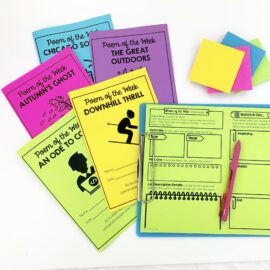









Leave a Comment
You must be logged in to post a comment.